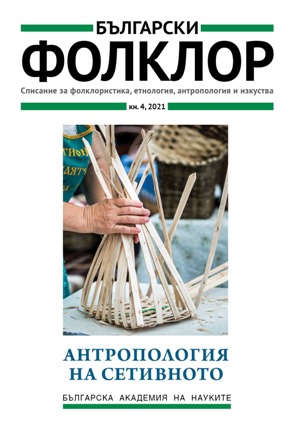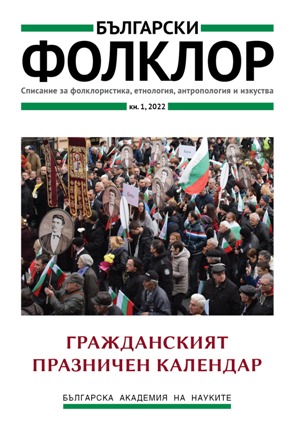
We kindly inform you that, as long as the subject affiliation of our 300.000+ articles is in progress, you might get unsufficient or no results on your third level or second level search. In this case, please broaden your search criteria.





The article is part of a series of observations related to the problem of the identity construction of the Easteauropean emigrants/immigrants “in the West” (Europe andUSA) before and after the “democratic changes”. Here, the author examines the first case (the second one is published in the second volume of the thematic issue “The Road”) which is based on materials from Estonia. The article shows the specifics of the Estonian labour mobility to Scandinavia in the context of the identification “main stays” developed by the Estonian society and related to the so-called popular religion and the neo-paganism which form a “working” national narrative.The article is based on the fieldwork of the author, published sources and Internet materials.
More...
The article offers a survey of the activities of the associations for friendship between Bulgarians and Greeks in Bulgaria in the last decades. These associations are viewed as a contemporary form of mutual cultural communication between the two peoples and the meaning of the two communities as a “bridge” between Bulgaria and Greece is highlighted. The study focuses on the present condition of these processes and on the impact of the COVID-19 pandemic on them. It examines concrete examples of changes in the activities of the associations in Sofia, which are indicative for the life of the communities with Greek self-identification in Bulgaria in the pandemic situation.
More...
Scientific life, conference report
More...
The International scientific conference "Disinformation: the new challenges" brought together 16 participants - established researchers, PhD students and journalists - from Bulgaria, USA, Canada, Germany. The presented papers reflect various aspects of the problem of disinformation: the impact of disinformation on political processes, regulatory approaches to curbing disinformation, journalistic practice of fact-checking and debunking disinformation, the role of social media in disseminating and amplifying disinformation.
More...
In the proposed text is sought to answer the question of whether and when we can talk about serialization in the international information flow. An attempt has been made for some systematization of the possible types of serialization, among which the anniversaries stand out. There are two major branches – the traditional serialization and the one generated by the possibilities of new technologies. The example with the ‘Tiananmen Papers’ is considered in more detail. It is also worth noting the borrowing serialization, shown in two examples of connecting processes in the present with such from the recent or very distant past.
More...
Paradoxically enough, our present times combine conservation with the destruction of architectural heritage. The preservation of this heritage is closely related to the foundation of the nation state and serves to show the “national genius” embodied by the peasant. Simultaneously, the different disciplines that study the issues of architectural heritage show that there is a tendency of mutual disregard. Nevertheless, the transnational concept of the rural home in Southeast Europe (mainly Romania and former Yugoslavia) which I have studied and documented in the 1970-s, displays similar features in close geographical zones, and also in zones that are marked by the culture and history of imperial colonization: Austrian in the first case and Ottoman in the second. The perspective from the point of view of regional heritage makes possible to apply a trans-border approach in order to reveal connections of kinship between neighboring villages separated by political boundaries. In the article, the differences between certain cultural areas are explained with the support of history.
More...
The article examines and analyses the process of “inventing” Kyustendil Spring Day in the context of socialist festivity. Based on the local tradition of welcoming spring in Kyustendil, which integrates pre-Christian rituals related to the day of spring solstice, the Day of Forty Martyrs of Sebaste in the Orthodox calendar and Mladentsi in the folk calendar, the holiday is gradually “domesticated” by the socialist authorities in the late 1960s, purged of its religious elements and re-invented – engaged with “new, socialist content”. Having combined various festive forms, symbols and rituals and occupying various urban spaces throughout the years, the holiday eventually established itself as a successful “invented tradition” during the socialist period, including several elements: a beauty contest, a ceremony for handing over the symbols of spring, a carnival procession, a public celebration on the Hisarlaka hill above the town, and accompanying cultural and sports events.
More...

I explore the connections between a particular place that was created by a natural agent (the Yantra River) and an artificial object (the ‘buna’), and the activities by which local people gave the place a specific character. I highlight their past actions and experiences; remembering, recounting and evaluations in the present; the emotional attachment to the place and the ecological nostalgia after its ‘loss’ due to hydro technical intervention.
More...
The use of expert knowledge is an essential part of media communication, especially during crises. The text highlights basic concepts of expertise, knowledge and journalists' understanding of their usage in media. The text analyzes the point of view of experts towards the critical function of journalism in the recognition of expert knowledge and its dissemination. For this purpose, interviews were conducted with 7 experts who participated in interviews and television shows during various crises. The text is part of a dissertation on "Expert speaking during crises and the critical function of journalism".
More...
The monograph is an up-to-date, rich and valuable study of an issue that does not fall often into the focus of media attention. Important for the overall understanding of what is happening in the countries of the Western Balkans is the presentation of the political and public attitudes towards the EU and NATO. The key stages of the Euro-Atlantic integration of the six countries are presented.Desislava Sotirova presents the importance of reconciliation between countries, peoples and ethnic groups, highlights the role and meaning of good neighborliness and regional cooperation, cooperation with the International Tribunal for the former Yugoslavia and the International Tribunal for Kosovo. An important element is the external influence in the region of the Western Balkans, of Russia, China, Turkey and Saudi Arabia.The coverage of the Euro-Atlantic integration of the countries of the Western Balkans was studied through three public media – BNR, Deutsche Welle and BBC. Among the approaches identified by the author in the media coverage, the observation that after the interest has been attracted, the media focus on the internal development of the six countries and out of their interest remains the extent to which the EU and NATO are prepared to accept new members.
More...
Cimitirele evreiești sunt o prețioasă sursă de informație despre evoluția comunităților cărora acestea le-au aparținut, despre orientarea lor rituală, raportată la curentele iudaismului tradițional ori ale celui modern, și despre interferențele dintre evrei și creștini, mai ales atunci când investigația vizează arta funerară și structura epitafurilor. Exemplul cimitirului evreiesc din Alba Iulia se încadrează în cea de-a doua categorie, fiind vorba despre o comunitate cu o tradiție remarcabilă, fapt ce a și influențat adeziunea ei la orientarea ortodoxă, dar care a receptat în timp influențe de tip reformator, care au determinat atitudini mult mai deschise față de noile idei. Tocmai de aceea, perspectiva istorică din prima parte a studiului, care se bazează pe cele mai importante surse documentare identificate (planuri ale cimitirului și un registru vechi al înmormântărilor redactat în mai multe etape de comunitate), include exemplificări ale tendințelor de evoluție a comunității și de modificare a structurii epitafurilor ori a tipului monumentelor funerare de la sfârșitul secolului al XIX-lea. În schimb, analiza epigrafică și cea artistică, stilistică și tipologică din celelalte două părți ale articolului, pentru a fi convingătoare, sunt mai strict circumscrise, făcând referire la o selecție a pietrelor funerare datând din secolul al XVIII-lea și din prima jumătate a secolului al XIX-lea. Diferența tipologică și stilistică între cele din secolul al XVIII-lea, pentru care pot fi sesizate similarități cu pietre tombale din alte cimitire europene inventariate, și cel puțin unele dintre cele secolul al XIX-lea este evidentă. Forme baroce clare caracterizează unele dintre monumentele edificate spre mijlocul secolului al XIX-lea, iar cele neogotice pe cele de mai târziu, de la sfârșitul aceluiași secol, ceea ce probează serioase întârzieri în receptarea lor. Conținutul inscripțiilor s-a modificat și el în cea de-a doua perioadă, reflectând o mai mare sensibilitate în cazul epitafurilor dedicate defuncților copii, acestea fiind susținute și de delicatețea simbolurilor care însoțesc textul. Obiectivul articolului a fost cel de a evidenția, prin intermediul analizelor epigrafice și stilistice, măsura în care orientarea rituală a comunității a fost cea ortodoxă. Răspunsul la această întrebare este afirmativ, dacă avem în vedere perioada istorică de circa două secole și jumătate scursă de la constituirea comunității și până spre finele secolului al XIX-lea. Dar în ultimele decenii ale acestui secol au început să apară elemente care anunțau o diversificare a orientărilor, probată de profilul monumentelor funerare amplasate în această perioadă în sectorul istoric al cimitirului și al celor din celelalte sectoare ale sale.
More...
This article analyses the role of skilled migration before and during the Covid-19 pandemic, emphasizing the health sector. Using official statistics, it investigates the evolution of the migrant skilled professionals from this sector over the last decade and the difficulties they face in different European countries. A special analysis is devoted to recognizing and validating the professional credentials of migrant healthcare workers and their crucial importance nowadays. Some comparisons have been made between the health sector in the UK and Spain by pointing out the importance of foreign doctors and nurses in mitigating the pandemic’s effect even during periods of lockdown and border closures. The conclusion of this research confirms the necessity of a collective and sustainable response to address the global shortage of health professional regulations and bureaucratic difficulties related to work permissions and authorizations in the post-Covid-19 recovery era.
More...
The article examines the funeral and memorial rites in the village of Breznitsa, Gocedelchev region. The specific local manifestations of the practices studied are presented in comparison with those of the other Muslim communities. Various elements of this rite are described both as prescriptions in the Koran and the Hadiths, and as the narrative tradition of the Bulgarian Muslims. The analysis of the connections between written and oral traditions shows the presence of an untransformed, ancient layer which continues to exist in parallel with the precepts of traditional Sunni Islam, characteristic of Ottoman culture. The field data used is gathered by the author in the period 2021–2023.
More...
The article concerns Georgian clothing in terms of gender and location. Georgian women`s and men`s clothes are characterized by their set, shape, color and embellishment. The examined material is kept at the national, regional, and private museums in Georgia. Material dates back to the 18th–20th centuries. For comparative purposes, clothes of Near East peoples are pointed out where we can witness its elements. Historic-ethnographic, comparative analytic, photographic, and material collection methods were used during research. Information preserved in the past was gathered with the aid of the historic method and the material acquired was analyzed through the use of knowledge gained in neighboring research disciplines. The means for restoring an overall picture reflecting the past were provided by the comparative analysis method.
More...